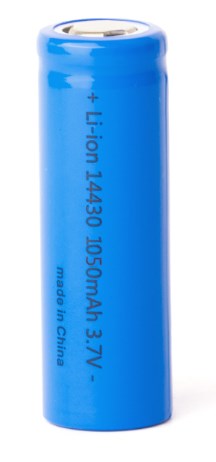The 14500 battery measures approximately 14mm in diameter and 50mm in length, while the 14430 battery is slightly smaller at about 14mm in diameter and 43mm in length. This size difference can affect compatibility with certain devices.
In the world of rechargeable batteries, understanding the dimensions and specifications of various types is crucial for ensuring compatibility with devices. This article delves into the specific differences between the 14500 and 14430 batteries, two popular lithium-ion battery sizes commonly used in a variety of electronic devices.
The dimensions of 14500 and 14430 batteries differ primarily in their length. The 14500 battery measures 50 mm in length, while the 14430 battery is shorter at 43 mm. Both batteries have a diameter of 14 mm, allowing them to fit into the same compartments. However, it’s important to note that devices designed for the longer 14500 battery may not function correctly with the shorter 14430 battery, and vice versa. Understanding these differences in dimensions is crucial for selecting the right battery for your electronic devices.
The dimensions differ significantly: a 14500 battery measures approximately 14mm in diameter by 50mm in length, while a 14430 battery is smaller at about 14mm in diameter by 30mm in length. This size difference affects their applications based on space constraints.
Overview of Battery Dimensions
Both the 14500 and 14430 batteries share a common diameter but differ significantly in length. This distinction is vital for manufacturers and consumers alike, as it affects which devices can utilize each battery type.
Dimensions Breakdown
- 14500 Battery:
- Diameter: 14 mm
- Length: 50 mm
- 14430 Battery:
- Diameter: 14 mm
- Length: 43 mm
Key Differences in Dimensions
1. Length Variation
The most significant difference between these two battery types is their length:
- The 14500 battery measures 50 mm, making it longer than its counterpart.
- The 14430 battery, at only 43 mm, is shorter by 7 mm.
This length difference may seem minor, but it can have substantial implications for device compatibility.
2. Diameter Consistency
Both batteries have a consistent diameter of 14 mm, which means they can fit into the same diameter-sized compartments. However, the length discrepancy is what ultimately determines their usability in specific devices.
Impact on Device Compatibility
The differing lengths of the 14500 and 14430 batteries mean that they are not interchangeable:
- Devices designed to accommodate the longer 14500 battery will not function correctly with the shorter 14430 battery, as there will be insufficient contact points for power delivery.
- Conversely, devices specifically designed for the 14430 battery may not have enough space to fit a longer 14500 battery, leading to potential damage or malfunction.
Applications of Each Battery Type
Understanding where each battery type is typically used can help clarify their importance:
14500 Battery Applications
The longer length of the 14500 battery allows it to house more energy capacity, making it suitable for:
- High-drain devices such as flashlights, power tools, and portable electronics.
- Applications requiring longer runtimes due to its greater energy density.
14430 Battery Applications
The shorter design of the 14430 battery makes it ideal for:
- Compact devices where space is limited, such as smaller flashlights, remote controls, and some medical devices.
- Devices that do not require high energy output but benefit from a smaller form factor.
Visual Comparison Chart
| Feature | 14500 Battery | 14430 Battery |
|---|---|---|
| Diameter | 14 mm | 14 mm |
| Length | 50 mm | 43 mm |
| Typical Applications | High-drain devices | Compact devices |
| Energy Capacity | Higher | Lower |
Recent Developments in Battery Technology
As of October 2024, there have been significant advancements in battery technology that impact both the 14500 and 14430 formats:
- The industry is witnessing a shift towards more efficient lithium-ion technologies that promise higher energy densities while maintaining or reducing size.
- Innovations in battery chemistry are leading to longer-lasting batteries with faster charging capabilities, which could redefine how we view traditional sizes like the 14500 and 14430.
Conclusion
In summary, while both the 14500 and 14430 batteries share a common diameter of 14 mm, their length difference—50 mm for the former and 43 mm for the latter—has critical implications for device compatibility. Understanding these dimensions is essential for selecting the right battery for your needs. As technology continues to evolve, staying informed about these specifications will ensure optimal performance in your electronic devices.
FAQs
Can I use a 14500 battery in place of a 14430 battery?
No, due to its longer length, a 14500 battery will not fit properly in a device designed for a 14430 battery.
What types of devices typically use a 14500 battery?
Devices such as high-drain flashlights, power tools, and other portable electronics often utilize the larger capacity of a 14500 battery.
Are there any advantages to using a shorter battery like the 14430?
Yes, the shorter design allows for use in compact devices where space is limited while still providing sufficient power for lower-drain applications.
Related:
How Do the Capacities of 14500 and 14430 Batteries Compare?
Are There Any Significant Performance Differences Between 14500 and 14430 Batteries?
What Are the Typical Uses for 14500 Batteries in Everyday Devices?
How Do the Dimensions of 14500 and 14430 Batteries Differ?
What Are the Main Applications for 14500 and 14430 Batteries?




